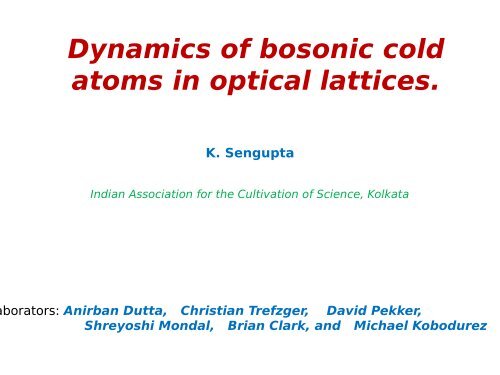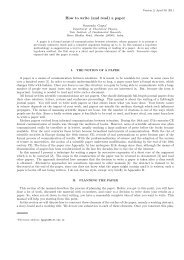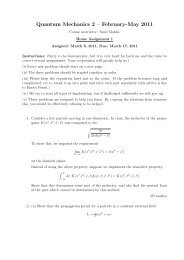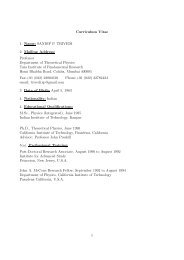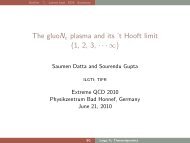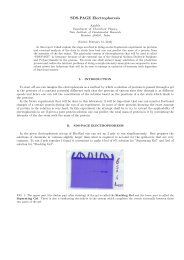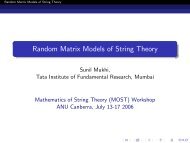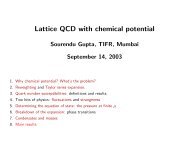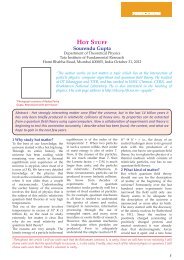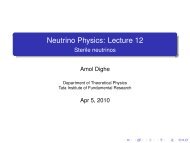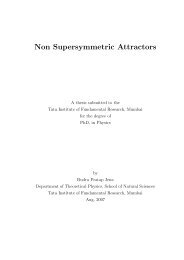Dynamics of bosonic cold atoms in optical lattices.
Dynamics of bosonic cold atoms in optical lattices.
Dynamics of bosonic cold atoms in optical lattices.
Create successful ePaper yourself
Turn your PDF publications into a flip-book with our unique Google optimized e-Paper software.
<strong>Dynamics</strong> <strong>of</strong> <strong>bosonic</strong> <strong>cold</strong><br />
<strong>atoms</strong> <strong>in</strong> <strong>optical</strong> <strong>lattices</strong>.<br />
K. Sengupta<br />
Indian Association for the Cultivation <strong>of</strong> Science, Kolkata<br />
borators: Anirban Dutta, Christian Trefzger, David Pekker,<br />
Shreyoshi Mondal, Brian Clark, and Michael Kobodurez
Overview<br />
1. Introduction to ultra<strong>cold</strong> bosons<br />
2. <strong>Dynamics</strong> <strong>of</strong> the Bose-Hubbard model<br />
3. <strong>Dynamics</strong> <strong>in</strong>duced freez<strong>in</strong>g<br />
4. Bosons <strong>in</strong> an electric field: Theory and<br />
experiments<br />
5. <strong>Dynamics</strong> <strong>of</strong> bosons <strong>in</strong> an electric field<br />
6. Conclusion
Introduction to ultra<strong>cold</strong> bosons
State <strong>of</strong> <strong>cold</strong> bosons <strong>in</strong> a lattice: experiment Bloch 2001
From BEC to the Mott state<br />
Apply counter<br />
propagat<strong>in</strong>g laser:<br />
stand<strong>in</strong>g wave <strong>of</strong> light.<br />
For a deep enough potential,<br />
the <strong>atoms</strong> are localized : Mott<br />
<strong>in</strong>sulator described by s<strong>in</strong>gle<br />
band Bose-Hubbard model.<br />
The <strong>atoms</strong> feel a potential V = -a |E|2<br />
Energy Scales<br />
δEn = 5Er ~ 20 U<br />
U ~10-300 t<br />
Model Hamiltonian<br />
20E r<br />
Ignore higher bands
Mott state with 1 boson per site<br />
Mott-Superfluid transition: prelim<strong>in</strong>ary analysis<br />
Stable ground state for 0 < m < U<br />
dd<strong>in</strong>g a particle to the Mott state<br />
Mott state is destabilized when<br />
the excitation energy touches 0.<br />
emov<strong>in</strong>g a particle from the Mott state<br />
ion <strong>of</strong> the Mott state via addition <strong>of</strong> particles/hole: onset <strong>of</strong> sup
Beyond this simple picture<br />
igher order energy calculation<br />
Freericks and Monien: Inclusion<br />
up to O(t3/U3) virtual processes.<br />
Mean-field theory (Fisher 89,<br />
Seshadri 93)<br />
Phase diagram for n=1 and d=3<br />
uantum Monte Carlo studies for<br />
D & 3D systems: Trivedi and Krauth,<br />
. Sansone-Capponegro<br />
MFT<br />
O(t2/U2) theories<br />
edicts a quantum phase<br />
nsition with z=2 (except at<br />
e tip <strong>of</strong> the Mott lobe where<br />
1).<br />
Mott<br />
Superfluid<br />
No method for study<strong>in</strong>g dynamics beyond mean-field theory
Projection Operator Method
Dist<strong>in</strong>guish<strong>in</strong>g between hopp<strong>in</strong>g processes<br />
Mott state<br />
Dist<strong>in</strong>guish between two types <strong>of</strong> hopp<strong>in</strong>g processes<br />
us<strong>in</strong>g a projection operator technique<br />
Def<strong>in</strong>e a projection operator<br />
Divide the hopp<strong>in</strong>g to classes (b) and (c)
Build<strong>in</strong>g fluctuations over MFT<br />
n a transformation which elim<strong>in</strong>ate hopp<strong>in</strong>g<br />
sses <strong>of</strong> class (b) perturbatively <strong>in</strong> J/U.<br />
ta<strong>in</strong> the effective Hamiltonian<br />
se the effective Hamiltonian<br />
compute the ground state<br />
nergy and hence the phase<br />
iagram
Equilibrium phase diagram<br />
Reproduction <strong>of</strong> the phase diagra<br />
with remarkable accuracy <strong>in</strong> d=3:<br />
much better than standard<br />
mean-field or strong coupl<strong>in</strong>g<br />
expansion <strong>in</strong> d=2 and 3.<br />
Accurate for large z as can be<br />
checked by compar<strong>in</strong>g with QMC<br />
data for 2D triangular (z=6)<br />
and 3D cubic lattice<br />
Allows for straightforward generalization for treatment <strong>of</strong> dynami
Non-equilibrium dynamics: L<strong>in</strong>ear ramp<br />
ider a l<strong>in</strong>ear ramp <strong>of</strong> J(t)=Ji +(Jf - Ji) t/t.<br />
ynamics, one needs to solve the Sch. Eq.<br />
a time dependent transformation<br />
dress the dynamics by project<strong>in</strong>g on<br />
nstantaneous low-energy sector.<br />
method provides an accurate description<br />
e ramp if J(t)/U
F<br />
Absence <strong>of</strong> critical scal<strong>in</strong>g: may<br />
be understood as the <strong>in</strong>ability <strong>of</strong><br />
the system to access the critical<br />
(k=0) modes.<br />
Fast quench from the Mott to the SF<br />
phase; study <strong>of</strong> superfluid dynamics.<br />
S<strong>in</strong>gle frequency pattern near the critica<br />
Po<strong>in</strong>t; more complicated deeper <strong>in</strong> the S<br />
phase.<br />
Strong quantum fluctuations near the Q<br />
justification <strong>of</strong> go<strong>in</strong>g beyond mft.
Experiments with ultra<strong>cold</strong> bosons on a lattice: f<strong>in</strong>ite rate dynamics<br />
EC conf<strong>in</strong>ed <strong>in</strong> a trap and <strong>in</strong> the presence<br />
<strong>optical</strong> lattice.<br />
e site imag<strong>in</strong>g done by light-assisted collision<br />
h can reliably detect even/odd occupation<br />
ite. In the present experiment they detect<br />
with n=1.<br />
from the SF side near the QCP to deep <strong>in</strong>side<br />
ott phase <strong>in</strong> a l<strong>in</strong>ear ramp with different<br />
rates.<br />
o. <strong>of</strong> sites with odd n displays plateau like<br />
vior and approaches the adiabatic limit<br />
the ramp time is <strong>in</strong>creased asymptotically.<br />
gnature <strong>of</strong> scal<strong>in</strong>g behavior. Interest<strong>in</strong>g<br />
al patterns.<br />
W. Bakr et al. Science 2010
Power law ramp<br />
Use a power-law ramp protocol<br />
Slope <strong>of</strong> both F and Q depends on<br />
a; however, the plateau-like behavior<br />
at large t is <strong>in</strong>dependent <strong>of</strong> a.<br />
Absence <strong>of</strong> Kibble-Zureck scal<strong>in</strong>g for<br />
any a due to lack <strong>of</strong> contribution <strong>of</strong><br />
small k (critical) modes <strong>in</strong> the dynamic
Periodic protocol: dynamics <strong>in</strong>duced freez<strong>in</strong>g
<strong>Dynamics</strong> <strong>in</strong>duced freez<strong>in</strong>g<br />
ne J from superfluid phase to Mott<br />
d back through the tip <strong>of</strong> the Mott lobe.<br />
Key result<br />
There are specific frequencies<br />
at which the wavefunction <strong>of</strong><br />
the system comes back to itself<br />
after a cycle <strong>of</strong> the drive<br />
lead<strong>in</strong>g to P=1-F -> 0.<br />
<strong>Dynamics</strong> <strong>in</strong>duced freez<strong>in</strong>g
Mean-field analysis: A qualitative picture<br />
Choose a gutzwiller wavefunction:<br />
The mean-field equations for fn<br />
En is the on-site energy <strong>of</strong> the<br />
state |n><br />
umerical solution <strong>of</strong> this equation<br />
icates that fn vanishes for n>2 for all<br />
ges <strong>of</strong> drive frequencies studied.<br />
nalysis <strong>of</strong> these equations leads to the<br />
elation <strong>in</strong>volv<strong>in</strong>g
us one can describe the system<br />
rms <strong>of</strong> three real variables : amplitude<br />
ate |1> and the sum and difference<br />
e relative phases.<br />
fs=f0+f2-2f1<br />
fd=f2-f0<br />
ne can construct a frequencypendent<br />
relation between r1 and fs<br />
Numerical solution <strong>of</strong> (6)<br />
There is a range <strong>of</strong> frequency for which<br />
r1 and fs rema<strong>in</strong> close to their orig<strong>in</strong>al<br />
values; dynamics <strong>in</strong>duced freez<strong>in</strong>g occur<br />
when fd/4p = n with<strong>in</strong> this range.
Robustness aga<strong>in</strong>st quantum fluctuations and presence <strong>of</strong> a trap<br />
Mean-field theory<br />
Projection operator formalism<br />
Density distribution <strong>of</strong><br />
the bosons <strong>in</strong>side a trap<br />
Robust freez<strong>in</strong>g<br />
phenomenon
Bosons <strong>in</strong> an electric field
Apply<strong>in</strong>g an electric field to the Mott<br />
state<br />
20E r<br />
Energy<br />
Scales:<br />
hων = 5Εr ≈ 20<br />
U<br />
U ≈10−300 J
Construction <strong>of</strong> an effective model:<br />
1D<br />
Parent Mott state
Charged excitations<br />
quasiparticle<br />
quasihole
Neutral dipoles<br />
Resonantly coupled to the<br />
parent Mott state when U=E.<br />
Neutral dipole state<br />
with energy U-E.<br />
Two dipoles which are not nearest<br />
neighbors with energy 2(U-E).
Effective dipole Hamiltonian: 1D
Weak Electric Field<br />
For weak electric field, the ground state is dipole vaccum and the low-energy<br />
excitations are s<strong>in</strong>gle dipole<br />
• The effective Hamiltonian for the dipoles for weak E:<br />
• Lowest energy excitations: S<strong>in</strong>gle band <strong>of</strong> dipole<br />
excitations.<br />
• These excitations s<strong>of</strong>ten as E approaches U. This is a<br />
precursor <strong>of</strong> the appearance <strong>of</strong> Is<strong>in</strong>g density wave with<br />
period 2.<br />
• Higher excited states consists <strong>of</strong> multiparticle<br />
cont<strong>in</strong>uum.
Strong Electric field<br />
The ground state is a state <strong>of</strong> maximum dipoles.<br />
Because <strong>of</strong> the constra<strong>in</strong>t <strong>of</strong> not hav<strong>in</strong>g two dipoles on<br />
consecutive sites, we have two degenerate ground states<br />
The ground state breaks Z2 symmetry.<br />
The first excited state consists <strong>of</strong> band <strong>of</strong> doma<strong>in</strong> walls<br />
between the two filled dipole states.<br />
Similar to the behavior <strong>of</strong> Is<strong>in</strong>g model <strong>in</strong> a transverse field.
Intermediate electric field: QPT<br />
Quantum phase transition<br />
at E-U=1.853w. Is<strong>in</strong>g<br />
universality.
Recent Experimental observation <strong>of</strong> Is<strong>in</strong>g order (Bakr et al Nature 20<br />
xperimental realization <strong>of</strong> effective Is<strong>in</strong>g model <strong>in</strong> ultra<strong>cold</strong> atom syst
Quench dynamics across the quantum critical po<strong>in</strong>t<br />
ne the electric field from<br />
i to Ef <strong>in</strong>stantaneously<br />
mpute the dipole order<br />
rameter as a function <strong>of</strong> time<br />
time averaged value <strong>of</strong> the order parameter is maximal near the QCP
Generic critical po<strong>in</strong>ts: A phase space argument<br />
system enters the impulse region when<br />
<strong>of</strong> change <strong>of</strong> the gap is the same order<br />
he square <strong>of</strong> the gap.<br />
slow dynamics, the impulse region is a<br />
ll region near the critical po<strong>in</strong>t where<br />
l<strong>in</strong>g works<br />
The system thus spends<br />
a time T <strong>in</strong> the impulse<br />
region which depends on<br />
the quench time<br />
his region, the energy gap scales as<br />
us the scal<strong>in</strong>g law for the defect<br />
nsity turns out to be<br />
neralization to f<strong>in</strong>ite system size<br />
ite-size scal<strong>in</strong>g
<strong>Dynamics</strong> with a f<strong>in</strong>ite rate: Kibble-Zureck scal<strong>in</strong>g<br />
ange the electric field l<strong>in</strong>early<br />
time with a f<strong>in</strong>ite rate v<br />
Theory<br />
uantities <strong>of</strong> <strong>in</strong>terest<br />
Experiment<br />
Scal<strong>in</strong>g laws for<br />
f<strong>in</strong>ite –size systems<br />
Q ~ v2 (v) for slow (<strong>in</strong>termediate) quench. These are<br />
termed as LZ(KZ) regimes for f<strong>in</strong>ite-size systems.
Kibble-Zureck scal<strong>in</strong>g for f<strong>in</strong>ite-sized system<br />
Observation <strong>of</strong> Kibble-Zurek law for<br />
Expected scal<strong>in</strong>g laws for Q and F<br />
<strong>in</strong>termediate v with Is<strong>in</strong>g exponents.<br />
Dipole dynamics<br />
Correlation function


